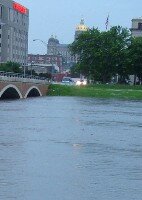Racing waters, UVA runners hit Des Moines
 DES MOINES, IOWA–- As the Des Moines River rose, the University of Virginia track and field team–- in town to compete in the NCAA Track and Field Championships– joined citizens in daily ventures downtown to witness Iowa's historic weather. Running downtown revealed overflowing sewer drains, restaurants desperately trying to stay in business while pumping water out of their basements and kitchens, and the ubiquitous sights of sandbags along streets, buildings, and bridges.
DES MOINES, IOWA–- As the Des Moines River rose, the University of Virginia track and field team–- in town to compete in the NCAA Track and Field Championships– joined citizens in daily ventures downtown to witness Iowa's historic weather. Running downtown revealed overflowing sewer drains, restaurants desperately trying to stay in business while pumping water out of their basements and kitchens, and the ubiquitous sights of sandbags along streets, buildings, and bridges.
"Seeing the before and after effects of the flood was amazing," says UVA third-year and newly-minted All-American discus thrower Billie Jo Grant. "To see how the city was affected economically, in addition to all the flooding, showed the depth of the effects natural disasters can have."
The four-day athletic event was projected to bring in millions of dollars in revenue for local hotels and restaurants, and although the games would eventually go on, the evacuation of the some hotels, including the Embassy Suites along the Des Moines River meant that 12 schools (not UVA) had to find other accommodations.
Several teams, such as the University of Washington and the University of South Carolina, took time out of competition to volunteer with the sandbagging that continues to occur in the streets adjacent to the river.
"Four of our athletes and I went down on Saturday and sandbagged for a couple of hours," says University of Washington assistant coach Jimmy Bean. "When people met us, they asked, 'What are you doing here, why are you doing this?'– we did it because we want to help other people."
Early Friday morning, Des Moines city officials ordered voluntary evacuations from the 500-year floodplain. Businesses and residents in the affected areas were required to evacuate by 6pm as neighbors elsewhere in Iowa are facing some of the worst flooding seen in decades. In what news sources have dubbed the "floods of '08," major cities–- such as Cedar Rapids and Iowa City–- have more than 500 city blocks underwater, racking up millions of dollars in potential damage.
In Iowa's capital city, the Des Moines River has steadily risen over the past week, as heavy rainfall and an overflowing dam has made the river's level rise to heights surpassing even the catastrophic flooding of 1993. At its peak, the Des Moines River reached 35.23 feet June 12, according to the US Army Corps of Engineers, with the previous record high watermark at 34.29 feet in 1993.
#